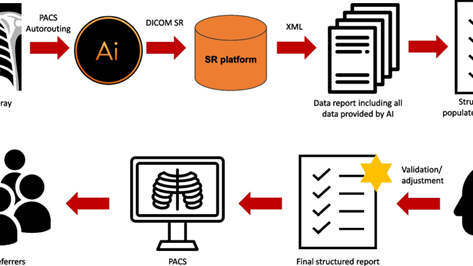
One of the reasons for the lack of proven impact of AI in radiology clinical practice is the challenge of integrating AI results into the radiology report. This study presents a novel reporting workflow for incorporating AI-generated results into structured radiology reports, with the aim of streamlining and improving the clinical impact of AI in radiology. By automatically incorporating AI findings into reports, the researchers show a significant reduction in reporting time and improvement in report quality compared to traditional methods. This highlights the potential of AI to improve efficiency and accuracy in radiology, and suggests a positive impact on clinical practice by facilitating better integration of AI tools.
Read full study
Abstract
Objectives: Artificial intelligence (AI) has tremendous potential to help radiologists in daily clinical routine. However, a seamless, standardized, and time-efficient way of integrating AI into the radiology workflow is often lacking. This constrains the full potential of this technology. To address this, we developed a new reporting pipeline that enables automated pre-population of structured reports with results provided by AI tools.
Methods: Findings from a commercially available AI tool for chest X-ray pathology detection were sent to an IHE-MRRT-compliant structured reporting (SR) platform as DICOM SR elements and used to automatically pre-populate a chest X-ray SR template. Pre-populated AI results could be validated, altered, or deleted by radiologists accessing the SR template. We assessed the performance of this newly developed AI to SR pipeline by comparing reporting times and subjective report quality to reports created as free-text and conventional structured reports.
Results: Chest X-ray reports with the new pipeline could be created in significantly less time than free-text reports and conventional structured reports (mean reporting times: 66.8 s vs. 85.6 s and 85.8 s, respectively; both p < 0.001). Reports created with the pipeline were rated significantly higher quality on a 5-point Likert scale than free-text reports (p < 0.001).
Conclusion: The AI to SR pipeline offers a standardized, time-efficient way to integrate AI-generated findings into the reporting workflow as parts of structured reports and has the potential to improve clinical AI integration and further increase synergy between AI and SR in the future.
Critical relevance statement: With the AI-to-structured reporting pipeline, chest X-ray reports can be created in a standardized, time-efficient, and high-quality manner. The pipeline has the potential to improve AI integration into daily clinical routine, which may facilitate utilization of the benefits of AI to the fullest.
Key points: • A pipeline was developed for automated transfer of AI results into structured reports. • Pipeline chest X-ray reporting is faster than free-text or conventional structured reports. • Report quality was also rated higher for reports created with the pipeline. • The pipeline offers efficient, standardized AI integration into the clinical workflow.
